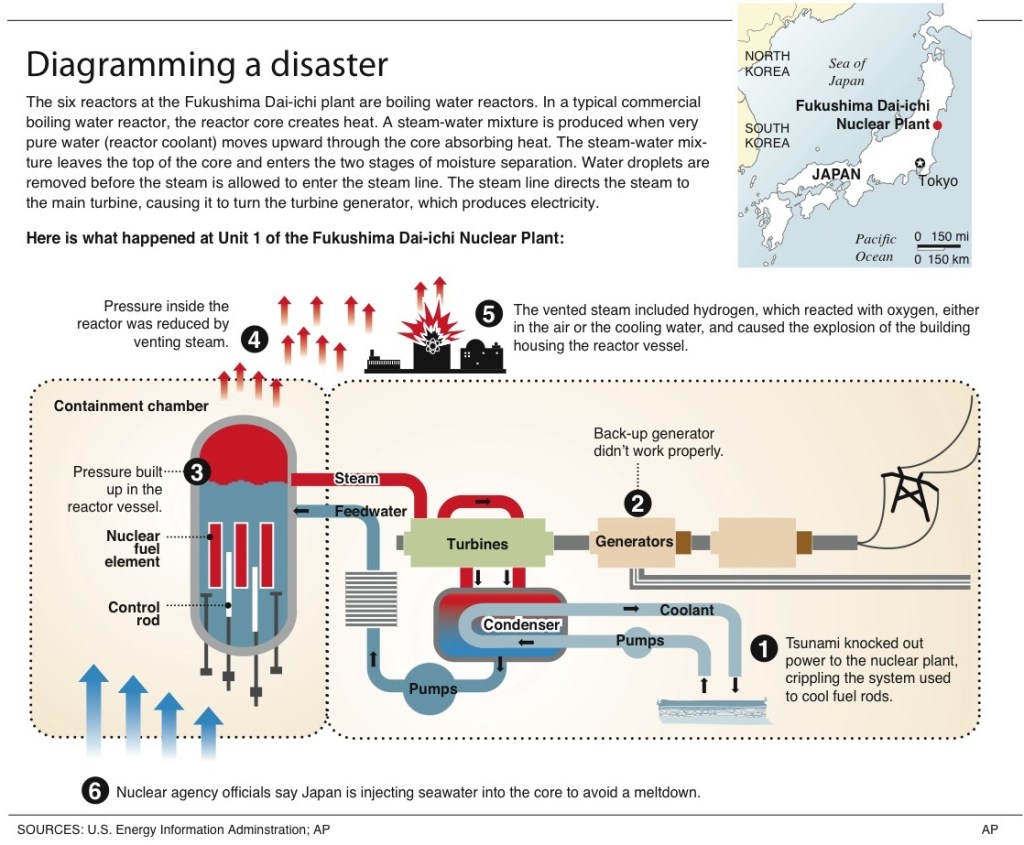A second explosion rocked Japan’s seaside Fukushima Dai-ichi nuclear complex today, this time destroying an outer building at unit 3. But officials asserted that the essential containment structures of the 37-year-old reactor survived intact.
Japanese officials had warned over the weekend that an explosion was possible as the plant’s owner, Tokyo Electric Power Co., fought to regain control of the reactor, whose normal cooling system was disrupted by last Friday’s earthquake and subsequent power outages.
Like the Saturday explosion at unit 1, this blast took place after a build up of hydrogen was vented by the reactor. The hydrogen was most likely produced by the exposure of the reactor’s fuel rods and their zirconium alloy casing to hot steam.
In normal conditions, the fuel rods would be covered and cooled by water.
The explosion took place as Tokyo Electric entered Day 4 of its battle against a cascade of failures at its two Fukushima nuclear complexes, using fire pumps to inject tens of thousands of gallons of seawater into two reactors to contain partial meltdowns of ultra-hot fuel rods.
The tactic produced high pressures and vapors that the company vented into its containment structures and then into the air, raising concerns about radioactivity levels in the surrounding area where people have already been evacuated. The utility said that at one of the huge, complicated reactors, a safety relief valve was opened manually to lower the pressure levels in a containment vessel.
But the limited vapor emissions were seen as far less dire than the consequences of failure in the fight against a more far-reaching partial or complete meltdown that would occur if the rods blazed their way through the reactor’s layers of steel and concrete walls.
The potential size of the area affected by radioactive emissions could be large. A state of emergency was declared briefly at another nuclear plant called Onagawa after elevated radioactivity levels were detected there. Later Japanese authorities blamed the measurement on radioactive material that had drifted from the Fukushima plant more than 75 miles away, according to the International Atomic Energy Agency.
The IAEA noted that forecasts said winds would be blowing to the northeast, away from the Japanese coast, over the next three days.
Tokyo Electric said that radioactivity levels both inside the plant and at its nearby monitoring post were higher than normal. Though levels had fallen Sunday, Kyodo News Agency said today that radiation at the plant’s premises rose over the benchmark limit of 500 micro sievert per hour at two locations, measuring 751 micro sievert at the first location at 2:20 a.m. on March 14 and 650 at the second at 2:40 a.m., according to information Tokyo Electric gave the government. The hourly amounts are more than half the 1,000 micro sievert to which people are usually exposed in one year.
In addition to one worker hospitalized for radiation exposure, two others felt ill during stints in the control rooms of Fukushima Dai-ichi units 1 and 2.
While Tokyo Electric said it also continued to deal with cooling system failures and high pressures at half a dozen of its 10 reactors in the two Fukushima complexes, fears mounted about the threat posed by the pools of water where years of spent fuel rods are stored.
At the 40-year-old Fukushima Dai-ichi unit 1, where an explosion Saturday destroyed a building housing the reactor, the spent fuel pool, in accordance with General Electric’s design, is placed above the reactor. Tokyo Electric said that it was trying to figure out how to maintain water levels in the pools, indicating that the normal safety systems there had failed too. Failure to keep adequate water levels in a pool would lead to a catastrophic fire, said nuclear experts, some of whom believe that unit 1’s pool may now be outside.
“That would be like Chernobyl on steroids,” said Arnie Gundersen, a nuclear engineer at Fairewinds Associates Inc. and a member of the public oversight panel for the Vermont Yankee nuclear plant, which is identical to the Fukushima Dai-ichi unit 1.
Gundersen said the unit 1 pool could have as much as 20 years of spent fuel rods, which are still radioactive.
At Fukushima Dai-ichi unit 3, Tokyo Electric said the government ordered a halt to the pumping of seawater for a time as pressures and hydrogen levels rose in the containment structure.
Victor Gilinsky, a former commissioner at the Nuclear Regulatory Commission, said that in order to produce hydrogen, temperatures inside the reactor core had to be well over 2,000 degrees and as high as 4,000 degrees Fahrenheit. He said a substantial amount of fuel had to be exposed at least at some point.
The Fukushima Dai-ichi unit 3, built by Toshiba, is 37 years old. Last year, the unit began using some reprocessed fuel known as “mox,” a mixture of plutonium oxide and uranium oxide, produced from recycled material from nuclear weapons as part of a program known as “from megatons to megawatts.” Anti-nuclear activists have called mox more unsafe than enriched uranium. If it escapes the reactor, plutonium even in small quantities can have much graver consequences on human health and the local environment for countless years, much longer than other radioactive materials.
Kyodo news agency cited Tokyo Electric as saying that more than three yards of a mox nuclear-fuel rod had been left above the water level, raising concerns that bits of plutonium or its byproducts may already be mixed into vapors or molten material. The Fukushima Dai-ichi unit 3, once capable of generating 784 megawatts of power, is substantially bigger than unit 1, which generated about 460 megawatts. As a result, getting temperatures in its reactor core could prove a much tougher task, experts said.
Send questions/comments to the editors.



Comments are no longer available on this story